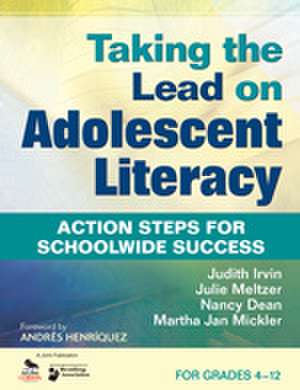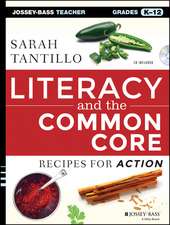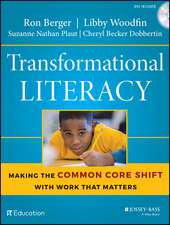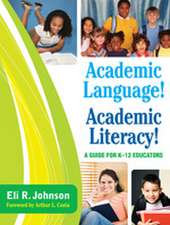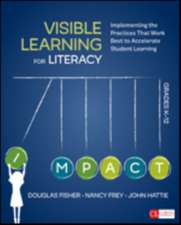Taking the Lead on Adolescent Literacy: Action Steps for Schoolwide Success
Editat de Judith L. Irvin, Julie Meltzer, Nancy D. Dean, Martha J. Mickleren Limba Engleză Paperback – 3 mai 2010
Taking the Lead on Adolescent Literacy presents a concrete, user-friendly, and practical guide to developing, implementing, and monitoring a schoolwide or county-wide literacy action plan. Readers will find rubrics, tools, and processes developed and field-tested by the authors over more than 10 years of close work with schools across the country.
Preț: 319.34 lei
Nou
Puncte Express: 479
Preț estimativ în valută:
61.11€ • 64.09$ • 50.87£
61.11€ • 64.09$ • 50.87£
Carte tipărită la comandă
Livrare economică 01-15 aprilie
Preluare comenzi: 021 569.72.76
Specificații
ISBN-13: 9781412979801
ISBN-10: 1412979803
Pagini: 248
Dimensiuni: 216 x 279 x 15 mm
Greutate: 0.68 kg
Ediția:1
Editura: SAGE Publications
Colecția Corwin
Locul publicării:Thousand Oaks, United States
ISBN-10: 1412979803
Pagini: 248
Dimensiuni: 216 x 279 x 15 mm
Greutate: 0.68 kg
Ediția:1
Editura: SAGE Publications
Colecția Corwin
Locul publicării:Thousand Oaks, United States
Recenzii
"The connections regarding best practice research from multiple fields—differentiation, professional development, curriculum mapping, 21st-century literacy, assessment, and instructional strategies—are critical and very well done. These connections are made in a professional, understandable way with theories and classroom applications articulated across grade levels and in many formats: scoring guides, prose, questions, vignettes, case studies, and graphics."
"Wow! This book gives school and district leaders and teams the what, why, and how to do the rocket science work of getting every student to read and write at grade level or above. Principals and literacy teams no longer need to be stuck in the 'We don’t know what to do next' world of frustration."
"This rich resource walks middle and high school literacy leaders through a comprehensive process for conceptualizing, initiating, and, most important, sustaining a schoolwide literacy learning program. The authors clearly know teachers and schools, and their reality-tested tools will prove invaluable in guiding and supporting middle and high school literacy leaders."
"The Literacy Project is a systemic process that guarantees all students access to superior instructional strategies."
"This literacy project changed the culture and focus of our school in less than a year. Following the process outlined in this book allowed our literacy team to personalize the project to our school and needs. Our team presented our project to our staff in August and our teachers have implemented it faithfully. Our students know the slogan and are excited about the project. The literacy team has kept the excitement high for the year."
"I have seen numerous educational initiatives come and go in my forty-some years working with schools, but nothing has been as important, relevant, or long lasting as adolescent literacy. Schools that have principals and teachers who have stayed the course with embedded literacy strategies across the curriculum, that focus on literacy rich culture and structures in their buildings, that have students using literacy strategies on their own, and that have staff and students reading and sharing, are the schools that make significant gains in their educational achievement."
"The most beneficial aspect of the literacy action planning process was providing training and asking for input from teachers from the very beginning. Literacy support team members were able to reflect on the unique and specific strengths and needs of their buildings and utilize this information to develop a practical implementation plan. The time spent working together on the literacy action plan helped build community and foster a sense of ownership in the change process."
"In each chapter I found honest descriptions of the tough issues faced by schools trying to focus on literacy across the content areas. More important, the chapters are full of guidelines and practical suggestions for dealing with those challenges. The implementation maps and the rubrics that help school literacy teams diagnose issues, establish goals, monitor implementation, and sustain changes are particularly valuable resources. The authors know that change requires a systems approach with all levels of school and community involved over an extended timeframe. I heartily recommend this as a very useful tool for schools wanting to implement a schoolwide commitment to literacy."
“The five-stage literacy leadership process in the book provided my principals and teachers with an easy-to-follow, researched-based guide to develop a successful literacy program within their schools.”
"As educators living in this world of high-stakes accountability, we need a way to focus our activities to be sure that our hard work is well spent. The literacy action planning process developed by Irvin and her colleagues has helped several schools in our district realistically assess their strengths and opportunities for improvement and develop concrete action plans for schoolwide literacy improvement."
"Wow! This book gives school and district leaders and teams the what, why, and how to do the rocket science work of getting every student to read and write at grade level or above. Principals and literacy teams no longer need to be stuck in the 'We don’t know what to do next' world of frustration."
"This rich resource walks middle and high school literacy leaders through a comprehensive process for conceptualizing, initiating, and, most important, sustaining a schoolwide literacy learning program. The authors clearly know teachers and schools, and their reality-tested tools will prove invaluable in guiding and supporting middle and high school literacy leaders."
"The Literacy Project is a systemic process that guarantees all students access to superior instructional strategies."
"This literacy project changed the culture and focus of our school in less than a year. Following the process outlined in this book allowed our literacy team to personalize the project to our school and needs. Our team presented our project to our staff in August and our teachers have implemented it faithfully. Our students know the slogan and are excited about the project. The literacy team has kept the excitement high for the year."
"I have seen numerous educational initiatives come and go in my forty-some years working with schools, but nothing has been as important, relevant, or long lasting as adolescent literacy. Schools that have principals and teachers who have stayed the course with embedded literacy strategies across the curriculum, that focus on literacy rich culture and structures in their buildings, that have students using literacy strategies on their own, and that have staff and students reading and sharing, are the schools that make significant gains in their educational achievement."
"The most beneficial aspect of the literacy action planning process was providing training and asking for input from teachers from the very beginning. Literacy support team members were able to reflect on the unique and specific strengths and needs of their buildings and utilize this information to develop a practical implementation plan. The time spent working together on the literacy action plan helped build community and foster a sense of ownership in the change process."
"In each chapter I found honest descriptions of the tough issues faced by schools trying to focus on literacy across the content areas. More important, the chapters are full of guidelines and practical suggestions for dealing with those challenges. The implementation maps and the rubrics that help school literacy teams diagnose issues, establish goals, monitor implementation, and sustain changes are particularly valuable resources. The authors know that change requires a systems approach with all levels of school and community involved over an extended timeframe. I heartily recommend this as a very useful tool for schools wanting to implement a schoolwide commitment to literacy."
“The five-stage literacy leadership process in the book provided my principals and teachers with an easy-to-follow, researched-based guide to develop a successful literacy program within their schools.”
"As educators living in this world of high-stakes accountability, we need a way to focus our activities to be sure that our hard work is well spent. The literacy action planning process developed by Irvin and her colleagues has helped several schools in our district realistically assess their strengths and opportunities for improvement and develop concrete action plans for schoolwide literacy improvement."
Cuprins
Foreword by Andres Henriquez
Acknowledgments
About the Authors
Part I. The Model, Process, and Rubrics
Rationale for a Schoolwide Focus on Literacy
Why Focus on Literacy?
How the Literacy Leadership Process Was Developed
The Five-Stage Literacy Leadership Process
How to Use the Literacy Leadership Process
Introduction: The Literacy Action Rubrics
Description of the Rubrics
Using the Literacy Action Rubrics
The Literacy Action Rubrics
Part II. Schoolwide Change in Five Stages
1. Stage 1: Get Ready
Step 1: Build an Effective Literacy Leadership Team
Step 2: Create a Vision of a Literacy-Rich School
Step 3: Use Data to Establish the Need for Literacy Improvement
Next Steps
2. Stage 2: Assess
Step 1: Identify School Strengths
Step 2: Summarize Key Messages From Your School Data
Step 3: Assess Current School Implementation Using the Literacy Action Rubrics
Step 4: Draft Literacy Action Goals
Next Steps
3. Stage 3: Plan
Step 1: Develop an Implementation Map for Each Literacy Action Goal
Step 2: Solicit Feedback From the School Community
Step 3: Revise Literacy Action Goal Statements and Implementation Maps
Step 4: Publish the Formal Literacy Action Plan
Next Steps
4. Stage 4: Implement
Step 1: Organize for Action
Step 2: Monitor and Troubleshoot Implementation
Step 3: Monitor Progress Toward Goals
Step 4: Plan How to Sustain Momentum
Next Steps
5. Stage 5: Sustain
Step 1: Summarize Progress Toward Goals
Step 2: Revise Implementation Maps
Step 3: Analyze Success as a Literacy Leadership Team
Step 4: Plan How to Sustain Momentum
Next Steps
Part III. Supporting School and District Administrators as Literacy Leaders
6. The Principal's Role
Support Literacy Leaders
The Five Action Points of the Taking Action Literacy Leadership Model
7. District Support
Communicate That Literacy Is a Priority
Provide Professional Development
Provide Specific Types of Fiscal Support
Establish Uniform Policies and Procedures Across the District
Use Data to Improve Instruction and Monitor Program Effectiveness
Develop and Implement a District Literacy Action Plan
Use the Five Action Points of the Taking Action Literacy Leadership Model
Review the District Plan to Ensure Alignment With State Planning and Advocacy
Resources
Resource A. School Vignettes
Resource B: Tools to Use When Implementing the Five-Stage Process
Resource C: Examples of Each Rubric Component in Action
Resource D: High School Case Study
Resource E: Matrix of Resources Available in Taking Action on Adolescent Literacy and Meeting the Challenge of Adolescent Literacy
Resource F: Glossary of Terms
References
Index
Acknowledgments
About the Authors
Part I. The Model, Process, and Rubrics
Rationale for a Schoolwide Focus on Literacy
Why Focus on Literacy?
How the Literacy Leadership Process Was Developed
The Five-Stage Literacy Leadership Process
How to Use the Literacy Leadership Process
Introduction: The Literacy Action Rubrics
Description of the Rubrics
Using the Literacy Action Rubrics
The Literacy Action Rubrics
Part II. Schoolwide Change in Five Stages
1. Stage 1: Get Ready
Step 1: Build an Effective Literacy Leadership Team
Step 2: Create a Vision of a Literacy-Rich School
Step 3: Use Data to Establish the Need for Literacy Improvement
Next Steps
2. Stage 2: Assess
Step 1: Identify School Strengths
Step 2: Summarize Key Messages From Your School Data
Step 3: Assess Current School Implementation Using the Literacy Action Rubrics
Step 4: Draft Literacy Action Goals
Next Steps
3. Stage 3: Plan
Step 1: Develop an Implementation Map for Each Literacy Action Goal
Step 2: Solicit Feedback From the School Community
Step 3: Revise Literacy Action Goal Statements and Implementation Maps
Step 4: Publish the Formal Literacy Action Plan
Next Steps
4. Stage 4: Implement
Step 1: Organize for Action
Step 2: Monitor and Troubleshoot Implementation
Step 3: Monitor Progress Toward Goals
Step 4: Plan How to Sustain Momentum
Next Steps
5. Stage 5: Sustain
Step 1: Summarize Progress Toward Goals
Step 2: Revise Implementation Maps
Step 3: Analyze Success as a Literacy Leadership Team
Step 4: Plan How to Sustain Momentum
Next Steps
Part III. Supporting School and District Administrators as Literacy Leaders
6. The Principal's Role
Support Literacy Leaders
The Five Action Points of the Taking Action Literacy Leadership Model
7. District Support
Communicate That Literacy Is a Priority
Provide Professional Development
Provide Specific Types of Fiscal Support
Establish Uniform Policies and Procedures Across the District
Use Data to Improve Instruction and Monitor Program Effectiveness
Develop and Implement a District Literacy Action Plan
Use the Five Action Points of the Taking Action Literacy Leadership Model
Review the District Plan to Ensure Alignment With State Planning and Advocacy
Resources
Resource A. School Vignettes
Resource B: Tools to Use When Implementing the Five-Stage Process
Resource C: Examples of Each Rubric Component in Action
Resource D: High School Case Study
Resource E: Matrix of Resources Available in Taking Action on Adolescent Literacy and Meeting the Challenge of Adolescent Literacy
Resource F: Glossary of Terms
References
Index
Descriere
Administrators will find a user-friendly, five-stage planning process with six essential rubrics for developing, implementing, monitoring, and sustaining a successful literacy initiative for Grades 4–12.
